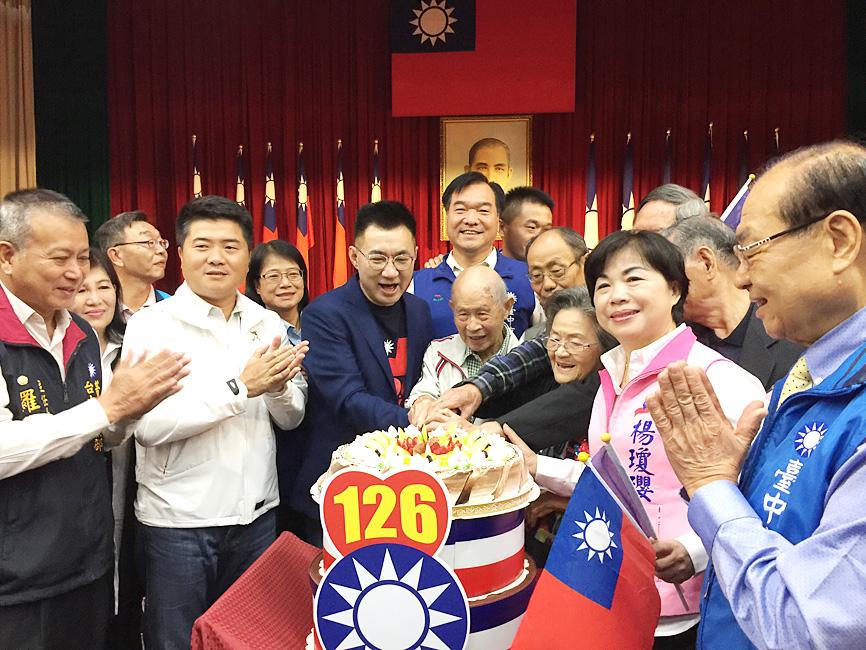The Chinese Nationalist Party (KMT) yesterday called on the government to reverse course on the lifting of a ban on US pork imports containing residues of ractopamine, warning that its supporters would otherwise again take to the streets.
The opposition cannot make the decision, but it can put pressure on the Democratic Progressive Party (DPP) to respond to public opinion, KMT Chairman Johnny Chiang (江啟臣) said at the 126th anniversary celebration of the founding of the Revive China Society held in Taichung.
Chiang’s comments came after the KMT and its supporters on Sunday last week participated in a labor rights protest in Taipei, calling on the government to not allow imports of US pork containing residues of the animal feed additive.

Photo: Su Meng-chuan, Taipei Times
Tens of thousands of people marched on the street that day, Chiang said.
If the DPP insists on lifting the ban and does not listen to the public, those opposing the imports would “find ways to express their anger,” he said, adding that the KMT would respect expressions of public opinion.
Asked about KMT Youth League leader Chen Po-hsiung (陳柏翰) calling for restraint after KMT lawmakers on Friday threw pig offal at Premier Su Tseng-chang (蘇貞昌), Chiang said: “The KMT is an inclusive political party, and different opinions can be discussed.”
“The greatest consensus within the KMT is that we oppose the government and respect public opinion,” Chiang said.
Chiang last week also invited President Tsai Ing-wen (蔡英文) to a televised debate on the issue.
In 2010, Tsai, then DPP chairperson, participated in a debate with then-president Ma Ying-jeou (馬英九) on the cross-strait Economic Cooperation Framework Agreement, Chiang said, adding that Tsai should once more come forward and debate the US pork issue, which is as much of concern to the public as the framework agreement.
Taiwanese consider their health national interest, he said.
In her announcement in August to lift the import ban from Jan. 1, Tsai said that the change in policy is “based on our national economic interests and consistent with our overall strategic goals for the future.”
Additional reporting by Su Meng-chuan

Taiwanese scientists have engineered plants that can capture about 50 percent more carbon dioxide and produce more than twice as many seeds as unmodified plants, a breakthrough they hope could one day help mitigate global warming and grow more food staples such as rice. If applied to major food crops, the new system could cut carbon emissions and raise yields “without additional equipment or labor costs,” Academia Sinica researcher and lead author the study Lu Kuan-jen (呂冠箴) said. Academia Sinica president James Liao (廖俊智) said that as humans emit 9.6 billion tonnes of carbon dioxide compared with the 220 billion tonnes absorbed

The Taipei Mass Rapid Transit (MRT) Wanda-Zhonghe Line is 81.7 percent complete, with public opening targeted for the end of 2027, New Taipei City Mayor Hou You-yi (侯友宜) said today. Surrounding roads are to be open to the public by the end of next year, Hou said during an inspection of construction progress. The 9.5km line, featuring nine underground stations and one depot, is expected to connect Chiang Kai-shek Memorial Hall Station to Chukuang Station in New Taipei City’s Jhonghe District (中和). All 18 tunnels for the line are complete, while the main structures of the stations and depot are mostly finished, he

Taipei is to implement widespread road closures around Taipei 101 on Friday to make way for large crowds during the Double Ten National Day celebration, the Taipei Department of Transportation said. A four-minute fireworks display is to be launched from the skyscraper, along with a performance by 500 drones flying in formation above the nearby Nanshan A21 site, starting at 10pm. Vehicle restrictions would occur in phases, they said. From 5pm to 9pm, inner lanes of Songshou Road between Taipei City Hall and Taipei 101 are to be closed, with only the outer lanes remaining open. Between 9pm and 9:40pm, the section is

China’s plan to deploy a new hypersonic ballistic missile at a Chinese People’s Liberation Army Rocket Force (PLARF) base near Taiwan likely targets US airbases and ships in the western Pacific, but it would also present new threats to Taiwan, defense experts said. The New York Times — citing a US Department of Defense report from last year on China’s military power — on Monday reported in an article titled “The missiles threatening Taiwan” that China has stockpiled 3,500 missiles, 1.5 times more than four years earlier. Although it is unclear how many of those missiles were targeting Taiwan, the newspaper reported